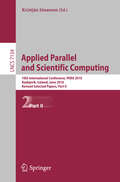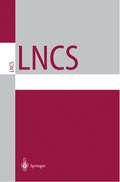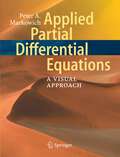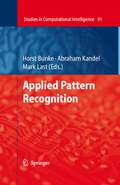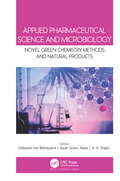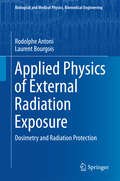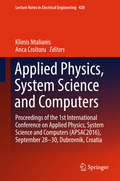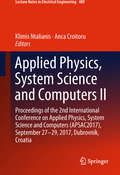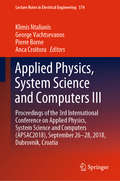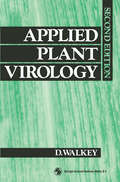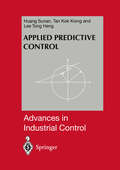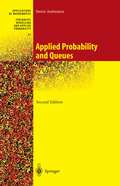- Table View
- List View
Applied Parallel and Scientific Computing: 10th International Conference, PARA 2010, Reykjavík, Iceland, June 6-9, 2010, Revised Selected Papers, Part II (Lecture Notes in Computer Science #7134)
by Kristján JónassonThe two volume set LNCS 7133 and LNCS 7134 constitutes the thoroughly refereed post-conference proceedings of the 10th International Conference on Applied Parallel and Scientific Computing, PARA 2010, held in Reykjavík, Iceland, in June 2010. These volumes contain three keynote lectures, 29 revised papers and 45 minisymposia presentations arranged on the following topics: cloud computing, HPC algorithms, HPC programming tools, HPC in meteorology, parallel numerical algorithms, parallel computing in physics, scientific computing tools, HPC software engineering, simulations of atomic scale systems, tools and environments for accelerator based computational biomedicine, GPU computing, high performance computing interval methods, real-time access and processing of large data sets, linear algebra algorithms and software for multicore and hybrid architectures in honor of Fred Gustavson on his 75th birthday, memory and multicore issues in scientific computing - theory and praxis, multicore algorithms and implementations for application problems, fast PDE solvers and a posteriori error estimates, and scalable tools for high performance computing.
Applied Parallel Computing. New Paradigms for HPC in Industry and Academia: 5th International Workshop, PARA 2000 Bergen, Norway, June 18-20, 2000 Proceedings (Lecture Notes in Computer Science #1947)
by Tor Sorevik Fredrik Manne Randi Moe Assefaw H. GebremedhinThe papers in this volume were presented at PARA 2000, the Fifth International Workshop on Applied Parallel Computing. PARA 2000 was held in Bergen, Norway, June 18-21, 2000. The workshop was organized by Parallab and the Department of Informatics at the University of Bergen. The general theme for PARA 2000 was New paradigms for HPC in industry and academia focusing on: { High-performance computing applications in academia and industry, { The use of Java in high-performance computing, { Grid and Meta computing, { Directions in high-performance computing and networking, { Education in Computational Science. The workshop included 9 invited presentations and 39 contributed pres- tations. The PARA 2000 meeting began with a one-day tutorial on OpenMP programming led by Timothy Mattson. This was followed by a three-day wor- hop. The rst three PARA workshops were held at the Technical University of Denmark (DTU), Lyngby (1994, 1995, and 1996). Following PARA’96, an - ternational steering committee for the PARA meetings was appointed and the committee decided that a workshop should take place every second year in one of the Nordic countries. The 1998 workshop was held at Ume a University, Sweden. One important aim of these workshops is to strengthen the ties between HPC centers, academia, and industry in the Nordic countries as well as worldwide. The University of Bergen organized the 2000 workshop and the next workshop in the year 2002 will take place at the Helsinki University of Technology, Espoo, Finland.
Applied Partial Differential Equations: A Visual Approach
by Peter MarkowichThis book presents topics of science and engineering which occur in nature or are part of daily life. It describes phenomena which are modelled by partial differential equations, relating to physical variables like mass, velocity and energy, etc. to their spatial and temporal variations. The author has chosen topics representing his career-long interests, including the flow of fluids and gases, granular flows, biological processes like pattern formation on animal skins, kinetics of rarified gases and semiconductor devices. Each topic is presented in its scientific or engineering context, followed by an introduction of applicable mathematical models in the form of partial differential equations.
Applied Pattern Recognition (Studies in Computational Intelligence #91)
by Horst Bunke Abraham Kandel Mark LastA sharp increase in the computing power of modern computers has triggered the development of powerful algorithms that can analyze complex patterns in large amounts of data within a short time period. Consequently, it has become possible to apply pattern recognition techniques to new tasks. The main goal of this book is to cover some of the latest application domains of pattern recognition while presenting novel techniques that have been developed or customized in those domains.
Applied Pharmaceutical Science and Microbiology: Novel Green Chemistry Methods and Natural Products
by Debarshi Kar Mahapatra Swati Gokul Talele A. K. HaghiThis volume on applied pharmaceutical science and microbiology looks at the latest research on the applications of natural products for drug uses. It focuses on understanding how to apply the principles of novel green chemistry methods in the vital area of pharmaceuticals and covers the important aspects of green microbial technology in the pharmaceutical industry. Chapters include studies on the applications of natural products used in folk and regional medicines, such as for digestive problems, dermatological infections, respiratory diseases, vessel diseases, diarrhea and dysentery, ringworms, boils, fevers (antipyretic), skin and blood diseases, mouth sores, channel discharges, and even cancer. The volume also looks at medical benefit of microbial fermentation for the conservation of nutrients.
Applied Photochemistry
by Rachel C. Evans, Peter Douglas and Hugh D. BurrowsApplied Photochemistry encompasses the major applications of the chemical effects resulting from light absorption by atoms and molecules in chemistry, physics, medicine and engineering, and contains contributions from specialists in these key areas. Particular emphasis is placed both on how photochemistry contributes to these disciplines and on what the current developments are.The book starts with a general description of the interaction between light and matter, which provides the general background to photochemistry for non-specialists. The following chapters develop the general synthetic and mechanistic aspects of photochemistry as applied to both organic and inorganic materials, together with types of materials which are useful as light absorbers, emitters, sensitisers, etc. for a wide variety of applications. A detailed discussion is presented on the photochemical processes occurring in the Earth’s atmosphere, including discussion of important current aspects such as ozone depletion. Two important distinct, but interconnected, applications of photochemistry are in photocatalytic treatment of wastes and in solar energy conversion. Semiconductor photochemistry plays an important role in these and is discussed with reference to both of these areas. Free radicals and reactive oxygen species are of major importance in many chemical, biological and medical applications of photochemistry, and are discussed in depth. The following chapters discuss the relevance of using light in medicine, both with various types of phototherapy and in medical diagnostics. The development of optical sensors and probes is closely related to diagnostics, but is also relevant to many other applications, and is discussed separately. Important aspects of applied photochemistry in electronics and imaging, through processes such as photolithography, are discussed and it is shown how this is allowing the increasing miniaturisation of semiconductor devices for a wide variety of electronics applications and the development of nanometer scale devices. The final two chapters provide the basic ideas necessary to set up a photochemical laboratory and to characterise excited states. This book is aimed at those in science, engineering and medicine who are interested in applying photochemistry in a broad spectrum of areas. Each chapter has the basic theories and methods for its particular applications and directs the reader to the current, important literature in the field, making Applied Photochemistry suitable for both the novice and the experienced photochemist.
Applied Photometry, Radiometry, and Measurements of Optical Losses (Springer Series in Optical Sciences #163)
by Michael BukshtabApplied Photometry, Radiometry, and Measurements of Optical Losses reviews and analyzes physical concepts of radiation transfer, providing quantitative foundation for the means of measurements of optical losses, which affect propagation and distribution of light waves in various media and in diverse optical systems and components. The comprehensive analysis of advanced methodologies for low-loss detection is outlined in comparison with the classic photometric and radiometric observations, having a broad range of techniques examined and summarized: from interferometric and calorimetric, resonator and polarization, phase-shift and ring-down decay, wavelength and frequency modulation to pulse separation and resonant, acousto-optic and emissive - subsequently compared to direct and balancing methods for studying free-space and polarization optics, fibers and waveguides. The material is focused on applying optical methods and procedures for evaluation of transparent, reflecting, scattering, absorbing, and aggregated objects, and for determination of power and energy parameters of radiation and color properties of light.
Applied Photovoltaics
by Richard Corkish Martin A Green Muriel E Watt Stuart R WenhamA reliable, accessible and comprehensive guide for students of photovoltaic applications and renewable energy engineering. This thoroughly considered textbook from a group of leading influential and award-winning authors is brimming with information and is carefully designed to meet the needs of its readers. Along with exercises and references at the end of each chapter, the book features a set of detailed technical appendices that provide essential equations, data sources and standards. Starting from basics with 'The Characteristics of Sunlight' the reader is guided step-by-step through semiconductors and p-n junctions; the behaviour of solar cells; cell properties ad design; and PV cell interconnection and module fabrication. The book covers stand-alone photovoltaic systems; specific purpose photovoltaic systems; remote are power supply systems; and grid-connected photovoltaic systems. There is also a section on photovoltaic water pumping system components and design. Applied Photovolatics is well illustrated and readable with an abundance of diagrams and illustrations, and will provide the reader with all the information needed to start working with photovoltaics.
Applied Photovoltaics
by Richard Corkish Martin A Green Muriel E Watt Stuart R WenhamA reliable, accessible and comprehensive guide for students of photovoltaic applications and renewable energy engineering. This thoroughly considered textbook from a group of leading influential and award-winning authors is brimming with information and is carefully designed to meet the needs of its readers. Along with exercises and references at the end of each chapter, the book features a set of detailed technical appendices that provide essential equations, data sources and standards. Starting from basics with 'The Characteristics of Sunlight' the reader is guided step-by-step through semiconductors and p-n junctions; the behaviour of solar cells; cell properties ad design; and PV cell interconnection and module fabrication. The book covers stand-alone photovoltaic systems; specific purpose photovoltaic systems; remote are power supply systems; and grid-connected photovoltaic systems. There is also a section on photovoltaic water pumping system components and design. Applied Photovolatics is well illustrated and readable with an abundance of diagrams and illustrations, and will provide the reader with all the information needed to start working with photovoltaics.
Applied Photovoltaics
by Stuart R. Wenham Martin A. Green Muriel E. Watt Richard Corkish Alistair SproulThe new edition of this thoroughly considered textbook provides a reliable, accessible and comprehensive guide for students of photovoltaic applications and renewable energy engineering. Written by a group of award-winning authors it is brimming with information and is carefully designed to meet the needs of its readers. Along with exercises and references at the end of each chapter, it features a set of detailed technical appendices that provide essential equations, data sources and standards. The new edition has been fully updated with the latest information on photovoltaic cells, modules, applications and policy. Starting from basics with 'The Characteristics of Sunlight' the reader is guided step-by-step through semiconductors and p-n junctions; the behaviour of solar cells; cell properties and design; and PV cell interconnection and module fabrication. The book covers stand-alone photovoltaic systems; specific purpose photovoltaic systems; remote area power supply systems; grid-connected photovoltaic systems and water pumping. Applied Photovoltaics is highly illustrated and very accessible, providing the reader with all the information needed to start working with photovoltaics.
Applied Photovoltaics
by Stuart R. Wenham Martin A. Green Muriel E. Watt Richard Corkish Alistair SproulThe new edition of this thoroughly considered textbook provides a reliable, accessible and comprehensive guide for students of photovoltaic applications and renewable energy engineering. Written by a group of award-winning authors it is brimming with information and is carefully designed to meet the needs of its readers. Along with exercises and references at the end of each chapter, it features a set of detailed technical appendices that provide essential equations, data sources and standards. The new edition has been fully updated with the latest information on photovoltaic cells, modules, applications and policy. Starting from basics with 'The Characteristics of Sunlight' the reader is guided step-by-step through semiconductors and p-n junctions; the behaviour of solar cells; cell properties and design; and PV cell interconnection and module fabrication. The book covers stand-alone photovoltaic systems; specific purpose photovoltaic systems; remote area power supply systems; grid-connected photovoltaic systems and water pumping. Applied Photovoltaics is highly illustrated and very accessible, providing the reader with all the information needed to start working with photovoltaics.
Applied Physics of Carbon Nanotubes: Fundamentals of Theory, Optics and Transport Devices (NanoScience and Technology)
by Slava V. Rotkin Shekhar SubramoneyApplied Physics of External Radiation Exposure: Dosimetry and Radiation Protection (Biological and Medical Physics, Biomedical Engineering)
by Rodolphe Antoni Laurent BourgoisThis book describes the interaction of living matter with photons, neutrons, charged particles, electrons and ions. The authors are specialists in the field of radiation protection. The book synthesizes many years of experiments with external radiation exposure in the fields of dosimetry and radiation shielding in medical, industrial and research fields. It presents the basic physical concepts including dosimetry and offers a number of tools to be used by students, engineers and technicians to assess the radiological risk and the means to avoid them by calculating the appropriate shields. The theory of radiation interaction in matter is presented together with empirical formulas and abacus. Numerous numerical applications are treated to illustrate the different topics. The state of the art in radiation protection and dosimetry is presented in detail, especially in the field of simulation codes for external exposure to radiation, medical projects and advanced research. Moreover, important data spread in different up to date references are presented in this book. The book deals also with accelerators, X-rays facilities, sealed sources, dosimetry, Monte Carlo simulation and radiation regulation. Each chapter is split in two parts depending on the level of details the readers want to focus on. The first part, accessible to a large public, provides a lot of simple examples to help understanding the physics concepts under radiation external exposure. The second part, called “Additional Information” is not mandatory; it aims on explaining topics more deeply, often using mathematical formulations. The book treats fundamental radiometric and dosimetric quantities to describe the interaction in materials under the aspects of absorbed dose processes in tissues. Definitions and applications on limited and operational radiation protection quantities are given. An important aspect are practical engineering tools in industrial, medical and research domains. Source characterization and shielding design are addressed. Also more ”exotic” topics, such as ultra intense laser and new generation accelerators, are treated. The state of the art is presented to help the reader to work with the book in a self-consistent way. The basic knowledge necessary to apply Monte Carlo methods in the field of radiation protection and dosimetry for external radiation exposure is provided. Coverage of topics such as variance reduction, pseudo-random number generation and statistic estimators make the book useful even to experienced Monte Carlo practitioners. Solved problems help the reader to understand the Monte Carlo process. The book is meant to be used by researchers, engineers and medical physicist. It is also valuable to technicians and students.
Applied Physics, System Science and Computers: Proceedings of the 1st International Conference on Applied Physics, System Science and Computers (APSAC2016), September 28-30, Dubrovnik, Croatia (Lecture Notes in Electrical Engineering #428)
by Klimis Ntalianis Anca CroitoruThis book reports on advanced theories and methods in three related fields of research: applied physics, system science and computers. It is organized in two main parts, the first of which covers applied physics topics, including lasers and accelerators; condensed matter, soft matter and materials science; nanoscience and quantum engineering; atomic, molecular, optical and plasma physics; as well as nuclear and high-energy particle physics. It also addresses astrophysics, gravitation, earth and environmental science, as well as medical and biological physics. The second part focuses on advances in system science and computers, exploring automatic circuit control, power systems, computer communication, fluid mechanics, simulation and modeling, software engineering, data structures and applications of artificial intelligence among other areas. Offering a collection of contributions presented at the 1st International Conference on Applied Physics, System Science and Computers (APSAC 2016), the book bridges the gap between applied physics and electrical engineering. It not only to presents new methods, but also promotes collaborations between different communities working on related topics at the interface between physics and engineering, with a special focus on communication, data modeling and visualization, quantum information, applied mechanics as well as bio and geophysics.
Applied Physics, System Science and Computers II: Proceedings of the 2nd International Conference on Applied Physics, System Science and Computers (APSAC2017), September 27-29, 2017, Dubrovnik, Croatia (Lecture Notes in Electrical Engineering #489)
by Klimis Ntalianis Anca CroitoruThis book reports on advanced theories and methods in three related fields of research: applied physics, system science and computers. It is organized in three parts, the first of which covers applied physics topics, including lasers and accelerators; condensed matter, soft matter and materials science; nanoscience and quantum engineering; atomic, molecular, optical and plasma physics; as well as nuclear and high-energy particle physics. It also addresses astrophysics, gravitation, earth and environmental science, as well as medical and biological physics. The second and third parts focus on advances in computers and system science, respectively, and report on automatic circuit control, power systems, computer communication, fluid mechanics, simulation and modeling, software engineering, data structures and applications of artificial intelligence among other areas. Offering a collection of contributions presented at the 2nd International Conference on Applied Physics, System Science and Computers (APSAC), held in Dubrovnik, Croatia on September 27–29, 2017, the book bridges the gap between applied physics and electrical engineering. It not only to presents new methods, but also promotes collaborations between different communities working on related topics at the interface between physics and engineering, with a special focus on communication, data modeling and visualization, quantum information, applied mechanics as well as bio and geophysics.
Applied Physics, System Science and Computers III: Proceedings of the 3rd International Conference on Applied Physics, System Science and Computers (APSAC2018), September 26-28, 2018, Dubrovnik, Croatia (Lecture Notes in Electrical Engineering #574)
by Klimis Ntalianis George Vachtsevanos Pierre Borne Anca CroitoruThis book reports on advanced theories and methods in three related fields of research: applied physics, system science and computers. The first part covers applied physics topics, such as lasers and accelerators; fluid dynamics, optics and spectroscopy, among others. It also addresses astrophysics, security, and medical and biological physics. The second part focuses on advances in computers, such as those in the area of social networks, games, internet of things, deep learning models and more. The third part is especially related to systems science, covering swarm intelligence, smart cities, complexity and more. Advances in and application of computer communication, artificial intelligence, data analysis, simulation and modeling are also addressed. The book offers a collection of contributions presented at the 3nd International Conference on Applied Physics, System Science and Computers (APSAC), held in Dubrovnik, Croatia on September 26–28, 2018. Besides presenting new methods, it is also intended to promote collaborations between different communities working on related topics at the interface between physics, computer science and engineering.
Applied Plant Virology
by D.G. WalkeyFor the past twenty years I have worked as an applied plant virologist, attempting to identify and control virus diseases in field crops. During the last ten years it has been my privilege to present short courses in plant virology to final-year students studying plant pathology, micro biology and general botany. Throughout the period I have been lecturing, it has been possible to recommend several excellent 'library' books for further reading in plant virology, but there has been no publication covering applied plant virology that a student might consider purchasing. With teaching requirements in mind this book has been written to provide a concise introduction to applied plant virology based on the experiences I have gained working on virus diseases, both in an applied laboratory and in the field. The text concentrates on introducing the reader to aspects of plant virology that would be encountered every day by an applied virologist trying to identify viruses and develop control measures for virus diseases of crop plants. Although a brief introduction to virus structure and its terminology is given in the opening chapter of the book, no attempt is made to cover in detail the more fundamental aspects of virus structure, biochemistry and replication. Similarly, the symptoms caused by individual viruses are not described, although the various types of symptoms that plant viruses cause and which might be encountered by a student or research worker are described.
Applied Plasticity (Mechanical Engineering Series)
by Jagabandhu ChakrabartyMechanical engineering, an engineering discipline forged and shaped by the needs of the industrial revolution, is once again asked to do its substantial share in the call for industrial renewal. The general call is urgent as we face profound issues of productivity and competitiveness that require engineering solutions, among others . The Mechanical Engineering Series features graduate texts and research monographs intended to address the need for information in contemporary areas of mechanical engineering. The series is conceived as a comprehensive one that covers a broad range of c- centrations important to mechanical engineering graduate education and research . We are fortunate to have a distinguished roster of consulting editors on the ad- sory board, each an expert in one of the areas of concentration . The names of the consulting editors are listed on the facing page of this volume . The areas of conc- tration are applied mechanics, biomechanics, computational mechanics, dynamic systems and control, energetics , mechanics of materials, processing, production systems, thermal science, and tribology .
Applied Plasticity, Second Edition (Mechanical Engineering Series)
by Jagabandhu ChakrabartyThis book begins with the fundamentals of the mathematical theory of plasticity. The discussion then turns to the theory of plastic stress and its applications to structural analysis. It concludes with a wide range of topics in dynamic plasticity including wave propagation, armor penetration, and structural impact in the plastic range. In view of the rapidly growing interest in computational methods, an appendix presents the fundamentals of a finite-element analysis of metal-forming problems.
Applied Polymer Rheology: Polymeric Fluids with Industrial Applications
by Marianna KontopoulouExplore polymer rheology from an industrial standpoint Presenting state-of-the-art polymer rheology as observed by well-recognized authors, Applied Polymer Rheology: Polymeric Fluids with Industrial Applications is designed to help readers understand the relationship between molecular structure and the flow behavior of polymers. In particular, it focuses on polymeric systems that elicit special attention from industry. Providing a comprehensive overview of the rheological characteristics of polymeric fluids, the book bridges the gap between theory and practice/application, enabling readers to see the connection between molecular structure and the behavior of the polymers studied. Beginning with a discussion of the properties, processability, and processing aids of specific polymers, later chapters examine filled polymers and composites, and the theoretical framework upon which their analysis is based. Various systems containing microstructure are presented subsequently, with the final chapter introducing paste extrusion of polytetrafluoroethylene paste. An invaluable reference guide that covers the literature and vast array of technical approaches to polymer rheology, Applied Polymer Rheology's coverage of polymeric fluids of interest to industry make it an essential resource for plastics, polymer, and chemical engineers, materials scientists, polymer chemists, and polymer physicists to use when interpreting findings and planning experiments.
Applied Polymer Rheology: Polymeric Fluids with Industrial Applications
by Marianna KontopoulouExplore polymer rheology from an industrial standpoint Presenting state-of-the-art polymer rheology as observed by well-recognized authors, Applied Polymer Rheology: Polymeric Fluids with Industrial Applications is designed to help readers understand the relationship between molecular structure and the flow behavior of polymers. In particular, it focuses on polymeric systems that elicit special attention from industry. Providing a comprehensive overview of the rheological characteristics of polymeric fluids, the book bridges the gap between theory and practice/application, enabling readers to see the connection between molecular structure and the behavior of the polymers studied. Beginning with a discussion of the properties, processability, and processing aids of specific polymers, later chapters examine filled polymers and composites, and the theoretical framework upon which their analysis is based. Various systems containing microstructure are presented subsequently, with the final chapter introducing paste extrusion of polytetrafluoroethylene paste. An invaluable reference guide that covers the literature and vast array of technical approaches to polymer rheology, Applied Polymer Rheology's coverage of polymeric fluids of interest to industry make it an essential resource for plastics, polymer, and chemical engineers, materials scientists, polymer chemists, and polymer physicists to use when interpreting findings and planning experiments.
Applied Polymer Science
by Ulf W. Gedde Mikael S. Hedenqvist Minna Hakkarainen Fritjof Nilsson Oisik DasThis companion volume to “Fundamental Polymer Science” (Gedde and Hedenqvist, 2019) offers detailed insights from leading practitioners into experimental methods, simulation and modelling, mechanical and transport properties, processing, and sustainability issues. Separate chapters are devoted to thermal analysis, microscopy, spectroscopy, scattering methods, and chromatography. Special problems and pitfalls related to the study of polymers are addressed. Careful editing for consistency and cross-referencing among the chapters, high-quality graphics, worked-out examples, and numerous references to the specialist literature make “Applied Polymer Science” an essential reference for advanced students and practicing chemists, physicists, and engineers who want to solve problems with the use of polymeric materials.
Applied Polyoxometalate-Based Electrocatalysis
by Diana M. FernandesWell-researched reference on stable alternative electrocatalysts and electrode materials with the potential to transform chemistry and processes in sensor- and energy-related technologies Applied Polyoxometalate-based Electrocatalysis delivers an overview of the variety of efficient applications of free POM and POM-based (nano)composites as exciting materials in the field of electrocatalysis. With a variety of sizes, shapes, composition, and physical and chemical properties, these composites have important properties, such as the ability to undergo reversible multivalence reductions/oxidations, leading to the formation of mixed-valence species, which brings about favorable electrocatalytic properties with regard to several electrochemical processes. Edited by a highly qualified independent researcher internationally recognized for her contributions to materials for electrochemical energy-related reactions, Applied Polyoxometalate-based Electrocatalysis includes information on: General methodologies used in the preparation of free POMs and POM-based nanocomposites and different strategies employed in electrode modification Role of POM-modified electrodes in oxidative and reductive electrocatalysis, including the detection/sensing of several (bio)molecules of interest and carbon dioxide electroreduction Application of POM-based (nano)composites, including the oxygen reduction reaction relevant to fuel cells, the oxygen and hydrogen evolution reactions, and batteries and supercapacitors Applied Polyoxometalate-based Electrocatalysis is an essential reference on the subject for chemists, material scientists, chemical engineers, and institutions involved in work related to free POM and POM-based (nano)composites.
Applied Predictive Control (Advances in Industrial Control)
by Sunan Huang Tong Heng LeeThis focused treatment includes the fundamentals and some state-of-the-art developments in the field of predictive control. A substantial part of the book addresses application issues in predictive control, providing several interesting case studies for more application-oriented readers.
Applied Probability and Queues (Stochastic Modelling and Applied Probability #51)
by Soeren Asmussen"This book is a highly recommendable survey of mathematical tools and results in applied probability with special emphasis on queueing theory....The second edition at hand is a thoroughly updated and considerably expended version of the first edition.... This book and the way the various topics are balanced are a welcome addition to the literature. It is an indispensable source of information for both advanced graduate students and researchers." --MATHEMATICAL REVIEWS
